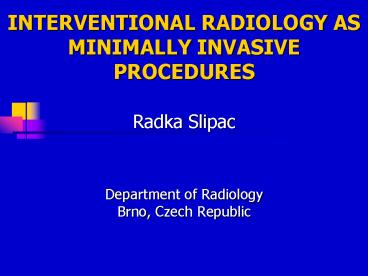INTERVENTIONAL RADIOLOGY AS MINIMALLY INVASIVE PROCEDURES - PowerPoint PPT Presentation
1 / 20
Title:
INTERVENTIONAL RADIOLOGY AS MINIMALLY INVASIVE PROCEDURES
Description:
INTERVENTIONAL RADIOLOGY AS MINIMALLY INVASIVE PROCEDURES Radka Slipac Department of Radiology Brno, Czech Republic What is Interventional Radiology? – PowerPoint PPT presentation
Number of Views:418
Avg rating:3.0/5.0
Title: INTERVENTIONAL RADIOLOGY AS MINIMALLY INVASIVE PROCEDURES
1
- INTERVENTIONAL RADIOLOGY AS MINIMALLY INVASIVE
PROCEDURES - Radka Slipac
- Department of Radiology Brno, Czech Republic
2
What is Interventional Radiology?
- Interventional radiology procedures are minimally
invasive, targeted treatments. - Interventional radiologists use imaging
equipments such as X-rays, ultrasound, CT and MRI
to guide small instruments such as catheters or
wires through the blood vessels or other pathways
to treat as well as diagnose diseases
percutaneously.
3
What are the Advantages of Interventional
Radiology?
- Interventional radiology procedures are generally
easier for the patient because - no general anesthesia
- no large incisions
- outpatient basis
- less risk
- less pain
- less blood loss
- less recovery times
- less expensive
4
What Procedures do Interventional Radiologist
Perform?
- Balloon angioplasty
- Biliary drainage and stenting
- Chemoembolization
- Embolization
- Radiofrequency ablation (RFA)
- Stenting
- Stent-graft
- Thrombolysis
- TIPS (transjugular intrahepatic
portosystemic shunt) - Cryotherapy
- Blood clot filters
5
CHEMOEMBOLIZATION
- Used mostly to treat primary liver cancers and
metastases of the liver. In about two-third of
cases the tumors are stopped or shrunk. - Using this unique principle
- The liver receives about 85 of its blood supply
through the portal vein and only 15 through the
hepatic artery. - But the tumor receives almost all of its supply
from the hepatic artery.
6
How Does Chemoembolization Work?
- Attacks the cancer in two ways
- very high concentration of chemotherapy in the
tumor is achieved by direct delivery through the
hepatic artery, sparing most of the healthy liver
tissue - ischaemia of the tumor is caused by embolization
of nourishing artery with embolic particles - This treatment preserves liver function and
relatively normal quality of life.
7
Superselective Chemoembolization of a Sole Liver
Metastasis
8
Chemoembolization of LiverMetastases of Gastric
Cancer
1. before TCE 2. regression
after 6 months 3. stabilized after 9 months
9
EMBOLIZATION
- Highly effective way of controlling bleeding from
injury, esp. in abdomen or pelvis, or stomach
ulcer, in an emergency situation. - Worldwide succesful treatment of uterine fibroids
with reduced menstrual bleeding, pelvic pain and
other complaints as an alternative to the
surgical removal of the uterus. - Effective treatment of tumors that either cannot
be removed surgically or would involve great risk
of surgery.
10
How Does Embolization Work?
- Delivery of clotting agents directly to a
bleeding or problematic area. - Temporary embolic agents such as Gelfoam (a
gelatin sponge material) block vessels for enough
time (days to weeks) for the body to heal the
problem causing the bleeding, f.e. injury or
gastric ulcer. - Permanent embolic agents such as Polyvinyl
alcohol (PVA) occlude vessels parmanently, f.e.
are used to embolize uterine fibroid tumors.
11
Bleeding from a Stomach Ulcer
Selective
arteriography Stopped after
of left gastric artery
Gelfoam embolization
12
Bleeding from Jejunum
Arteriography of superior Stopped after
superselective mesenteric artery
metal coils embolization
13
Uterine Fibroid Embolization
Angiography of right uterine artery and
embolization
MRI of uterine fibroid visible before and
invisible 6 months after embolization
14
AORTIC STENTGRAFTS
- Endovascular repair of abdominal aorta aneurysm
(AAA) with a fabric-wrapped flexible mesh tube. - Prevention of enlargement or life-threatening
rupture of AAA. - Less invasive, less blood loss, effective and
safe alternative especially for patients with
great risk of surgery.
15
How Does Aortic Stentgrafts Work?
- An appropriate type of self-expanding stentgraft
is inserted through the femoral artery and placed
at the site of the aneurysm of abdominal aorta. - Stentgraft bridges the aneurysm inside and
eliminates the blood flow in aneurysmal sac. - Reduction of the aneurysmal sac and decrease of
the pressure on the aortic wall as an effective
prevention of rupture.
16
Various Aortic Stentgrafts
17
Aortic Stentgrafts
18
Subrenal Abdominal Aortic Aneurysm
Angiography before and after implantation of
stentgraft
19
Implantation of Bifurcated Aortic Stentgraft
Aortography before CT after 6 months
CT after one year
20
CONCLUSIONS
- Interventional radiology procedures are an
advance in medicine that often replace open
surgical procedures. - These minimally invasive procedures involve less
blood loss and thus play an important role in
bloodless medicine.































